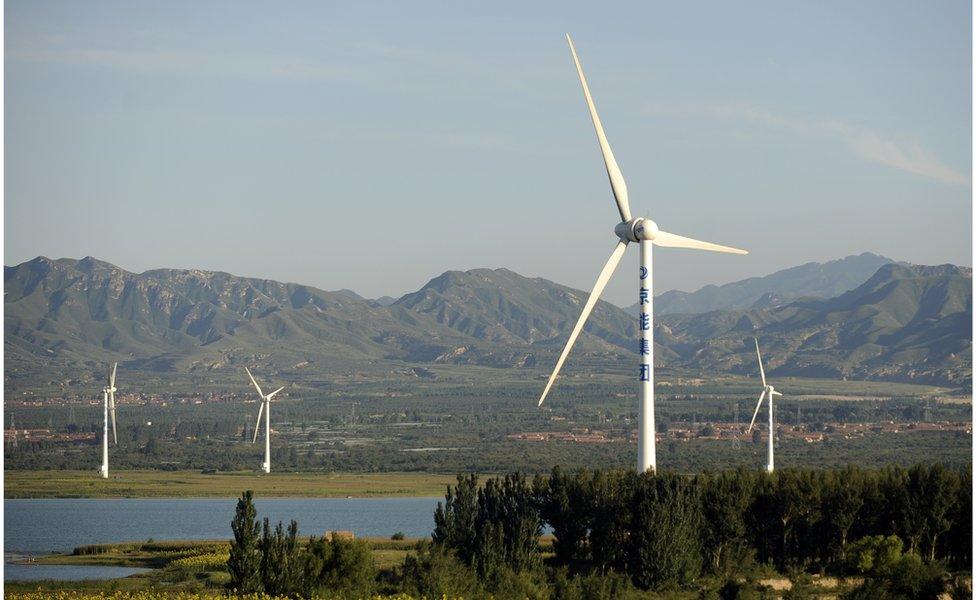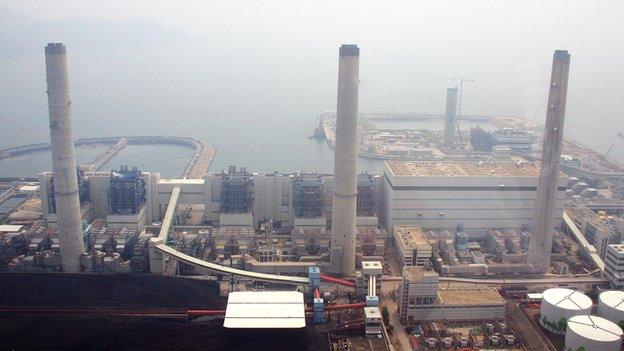China's about-face on climate change
- Published
China builds the world's largest solar power farm
With a hard pledge on peaking carbon emissions and with ever more ambitious targets on installing renewables, China has become one of the countries to watch at this week's Paris conference.
The Qinghai Tibet plateau is the heart and lungs of Asia. Here, the continent's weather is made and its great rivers are born.
The altitude and the cold make it one of the most extreme climates on earth.
When I visited, icy winds gusting at 50mph (80km/h) were whipping a sandstorm into Qie Qun Jia's face as he herded his flock of sheep home to safety.
The 28-year-old Tibetan nomad has only ever known this life.
But climate change is turning the grasslands that once supported his yak herd to desert, and now Qie Qun Jia has only a flock of sheep.

Qie Qun Jia has struggled with the shrinking grasslands
"When I was little the grass grew tall and the mountains were covered with flowers," he says.
"Summers were warmer and winters were much colder. But in recent years there've been so many sandstorms, the flowers are disappearing and the grazing gets worse year by year.
So our flocks of sheep are shrinking. We can't afford to buy grass to feed them."
Counting the cost
China is both a victim and a perpetrator of climate change.
After three-and-a-half decades of headlong industrial growth powered by coal, China is the world's largest polluter, and now it is counting the cost in climate change and environmental damage.
In the north and west, it faces desertification. In the south and east, it battles flooding. Its population endures some of the world's most polluted air, soil and water.

Most of China's top polluted cities are in the industrial north-east of the country
Since the last global UN climate conference in 2009 when Beijing was unwilling to commit to hard targets on reducing carbon emissions, it has realised that its dependence on fossil fuels has to stop. It has become a climate convert.
This about-face is driven not just by the ever more alarming threats from devastating climate change and pollution, but also by opportunity.
China believes the world is on the brink of an energy revolution and it sees a chance to dominate, and profit from, the new technologies of a greener century.
After putting industrial growth above the environment for so long, the Chinese government now believes sustainable growth can only come from rescuing the environment. Tackling climate change is in the national interest.
Solar energy's big moment
The Huanghe solar farm on the Qinghai plateau claims to be the biggest of its kind in the world. Nearly four million solar panels tilt up towards a vast blue dome of sky.
As I walked between the rows with senior engineer Shen Youguo, tumble weed and sand blew into us and the wind was bitter, but he's excited. It's a big moment to be in solar energy in China.
"What we're doing right now is for the sky to be bluer and the water to be clearer. We want a better future for everybody. So we're committed to being a part of that push," he says.
The International Energy Agency predicts that solar power will be the world's leading source of electricity by the middle of this century.
Carrie Gracie explains China's plans for solar energy
China wants to dominate renewable technologies like this, and competition between its manufacturers is driving down costs not just in China but globally, as Mr Shen explains.
"As technology advances, the efficiency of our solar batteries improves and the costs come down. So there's bound to come a day when solar power becomes cheaper than traditional energy.
Personally I'm very optimistic about it," he says.
Even the environmental activists are impressed.
Yuan Ying of Greenpeace says there are still many challenges to integrate renewable energy fully on China's national grid, but that the overall trend is positive.
"China is now showing more willingness to lead the international effort to tackle climate change. We also hope China's efforts can inspire other countries to follow," says Yuan Ying.

China has also been investing in wind farms
Back on the Qinghai plateau, Qie Qun Jia puts his sheep to bed and the sandstorm drives him in from the cold to sit by the stove with a bowl of steaming milk tea.
In the old days he lived in a tent, but he now has a two room house with a solar panel just outside the door.
The light bulb hanging from the ceiling is solar powered as is the TV on which his children are watching cartoons. He worries about what will become of them in the future.
"We grew up so freely, raising our cattle on this vast grassland. Every day was fun. But our sons and daughters can't continue this herding life. There's no road ahead for them. I feel very sad," he says.
It will take generations to cure China's addiction to coal and embed renewable energy at the heart of its economy. And all the while, the grassland is shrinking.
Even with an agreement in Paris and even with stronger pledges in the years ahead, the self-inflicted scars of climate change in China may yet deepen before they heal.
- Published2 March 2015

- Published30 June 2015
